The Winnifred Eaton Archive
Romancer — Journalist — Screenwriter
The wild and wonderful career of a pioneer Asian North American writer
The Winnifred Eaton Archive is a research and teaching tool that offers over 300 works by Winnifred Eaton Babcock Reeve (1875-1954). Winnifred Eaton was a popular early Asian North American author, journalist, screenwriter and playwright whose best known works were published under the pen-name “Onoto Watanna,” a controversial persona that she assumed for over two decades. She was also the sister of Edith Eaton (“Sui Sin Far”). Drawing on the resources of libraries and special collections from around the world, this digital archive provides freely accessible scans and fully searchable transcriptions of much of Winnifred Eaton’s collected oeuvre. Our goal is to provide a more complete picture of this complex and problematic figure. The archive will expand as Eaton’s known oeuvre expands. It also houses supplemental materials: photographs, reviews, illustrations, a biography, a bibliography, and unpublished manuscripts.
Read More
Featured Items
1234567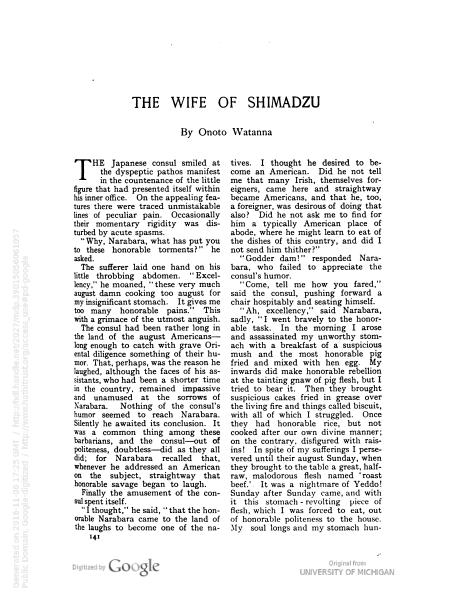 The Wife of ShimadzuShimadzu, the owner of a quiet Japanese restaurant tucked away inside a New York City brownstone, horrifies his Japanese patrons when his new wife cashes in on Japanese stereotypes to attract American customers. But the Wife of Shimadzu plays only a minor role in this story. At its center are the sensitive artist Narabara and the coyly named half-Japanese heroine Otama Wallace, who find love—and choose the “better part” of their respective cultural and racial identities—in the urban cosmopolitanism of turn-of-the century New York.
Read More
Written by Jean Lee Cole
The Wife of ShimadzuShimadzu, the owner of a quiet Japanese restaurant tucked away inside a New York City brownstone, horrifies his Japanese patrons when his new wife cashes in on Japanese stereotypes to attract American customers. But the Wife of Shimadzu plays only a minor role in this story. At its center are the sensitive artist Narabara and the coyly named half-Japanese heroine Otama Wallace, who find love—and choose the “better part” of their respective cultural and racial identities—in the urban cosmopolitanism of turn-of-the century New York.
Read More
Written by Jean Lee Cole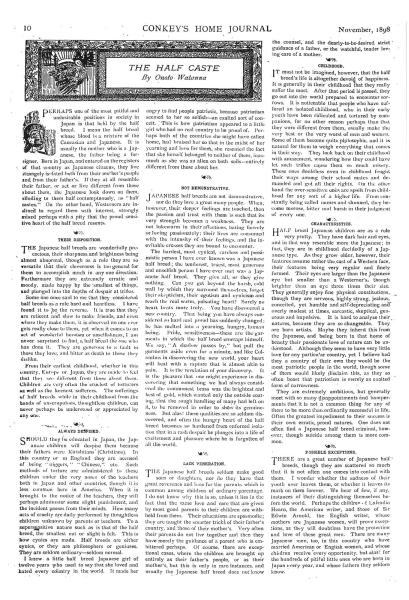 The Half CasteAs one might expect, Winnifred Eaton’s writing commonly displays deep sympathy for mixed-race people and sometimes portrays them in unconventional ways. Nevertheless, nonfiction works like “The Half Caste” show she was not immune to the popular logic of scientific racism. Claiming that each race possessed fixed biological characteristics, scientific racism contributed to notions that mixed-race people were, by nature, volatile and internally divided. While Eaton remarks, here, that half castes are often beautiful and intelligent, she discusses their emotional dispositions in terms that sometimes suggest mental illness. Her observation about suicide, in the penultimate section, gestures to the figure of the “tragic mulatto,” a popular nineteenth-century literary trope of doomed racial hybridity. Although the subject of Eaton’s observations is the mixed-race person of Japanese and European descent, her use of the term “half caste”—originating in the British Empire, where it frequently referred to persons of mixed European and Indian descent—suggests a broader characterization of mixed-race experience.
Read More
Written by Spencer Tricker
The Half CasteAs one might expect, Winnifred Eaton’s writing commonly displays deep sympathy for mixed-race people and sometimes portrays them in unconventional ways. Nevertheless, nonfiction works like “The Half Caste” show she was not immune to the popular logic of scientific racism. Claiming that each race possessed fixed biological characteristics, scientific racism contributed to notions that mixed-race people were, by nature, volatile and internally divided. While Eaton remarks, here, that half castes are often beautiful and intelligent, she discusses their emotional dispositions in terms that sometimes suggest mental illness. Her observation about suicide, in the penultimate section, gestures to the figure of the “tragic mulatto,” a popular nineteenth-century literary trope of doomed racial hybridity. Although the subject of Eaton’s observations is the mixed-race person of Japanese and European descent, her use of the term “half caste”—originating in the British Empire, where it frequently referred to persons of mixed European and Indian descent—suggests a broader characterization of mixed-race experience.
Read More
Written by Spencer Tricker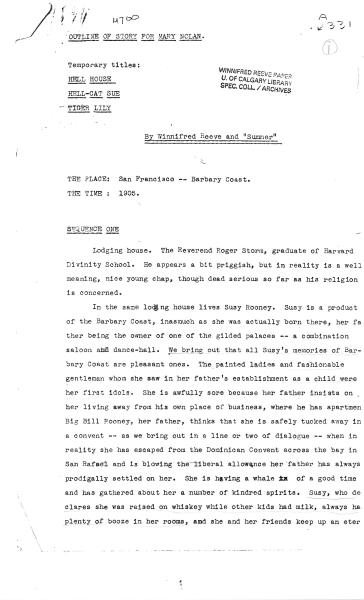 Barbary Coast OutlineIn 1929, Winnifred Eaton wrote an original screenplay outline that tells the story of a young reformer who falls in love with a girl from the San Francisco underworld and realizes the limits of his reformist ideology. Through its sympathetic representation of underworld characters, Barbary Coast challenged the censorship guideline popularly known as the Hays Code and the reformist zeal that necessitated it. It also reflected the industry’s confused shift from silent to sound films through its unconventional form—as it features dialogues, notes about post-production, shot specifications, and set descriptions. In particular, these set descriptions, with their nuanced attention to visual and auditory detail, showcase how Eaton translated her faculty for conjuring evocative visions of time and place (seen previously in texts like A Japanese Nightingale and Cattle) into the novel medium of film.
Read More
Written by Ethan Eu and Thomas Playfair
Barbary Coast OutlineIn 1929, Winnifred Eaton wrote an original screenplay outline that tells the story of a young reformer who falls in love with a girl from the San Francisco underworld and realizes the limits of his reformist ideology. Through its sympathetic representation of underworld characters, Barbary Coast challenged the censorship guideline popularly known as the Hays Code and the reformist zeal that necessitated it. It also reflected the industry’s confused shift from silent to sound films through its unconventional form—as it features dialogues, notes about post-production, shot specifications, and set descriptions. In particular, these set descriptions, with their nuanced attention to visual and auditory detail, showcase how Eaton translated her faculty for conjuring evocative visions of time and place (seen previously in texts like A Japanese Nightingale and Cattle) into the novel medium of film.
Read More
Written by Ethan Eu and Thomas Playfair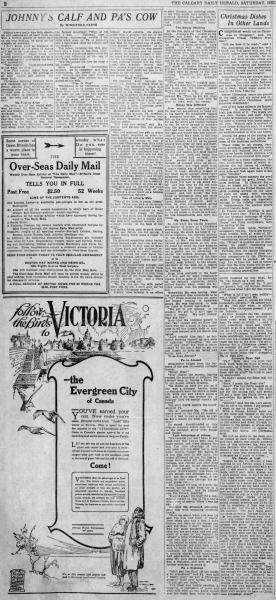 Johnny’s Calf and Pa’s Cow“Johnny’s Calf and Pa’s Cow” is one of many stories Eaton set on the prairie after her relocation
to Alberta ranch country. Her characters, marked predominantly by vulgar rawness with fleeting
moments of affection, offer readers a glimpse of Canadian prairie life. Eaton appears to leave
Johnny’s hard-working mother intriguingly out of her title just as Pa, in the story itself, cannot recognize Ma’s significant
contributions to their household. Perhaps she is like Pa’s cow, milked for all its worth?
Read More
Written by Sijia Cheng
Johnny’s Calf and Pa’s Cow“Johnny’s Calf and Pa’s Cow” is one of many stories Eaton set on the prairie after her relocation
to Alberta ranch country. Her characters, marked predominantly by vulgar rawness with fleeting
moments of affection, offer readers a glimpse of Canadian prairie life. Eaton appears to leave
Johnny’s hard-working mother intriguingly out of her title just as Pa, in the story itself, cannot recognize Ma’s significant
contributions to their household. Perhaps she is like Pa’s cow, milked for all its worth?
Read More
Written by Sijia Cheng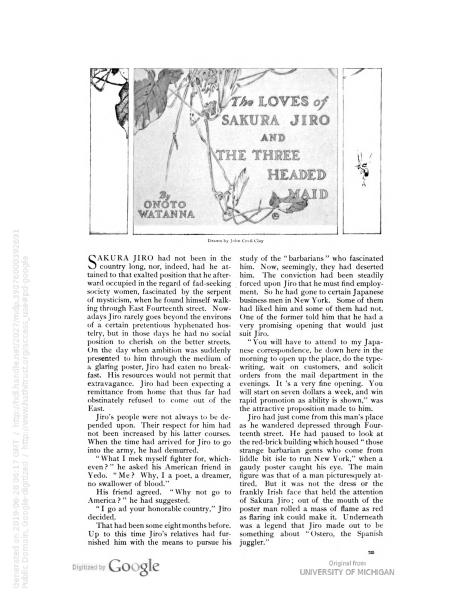 The Loves of Sakura Jiro and the Three Headed MaidThe freak show and the dime museum trace their roots to New York’s American Museum, established by P.T. Barnum in 1841, which featured such attractions as the Feejee Mermaid and the “Siamese Twins,” Chang and Eng Bunker. By 1903, when Eaton published “The Loves of Sakura Jiro and the Three Headed Maid” in the highly respected Century Magazine, the freak show was firmly entrenched in American popular culture. In this story, Eaton introduces Japanese identity as a new kind of “freak” (with a nod to the 1893 Columbian Exposition’s Midway Plaisance) and shows how the resourceful Sakura Jiro is able to parlay that identity to his advantage.
Read More
Written by Jean Lee Cole
The Loves of Sakura Jiro and the Three Headed MaidThe freak show and the dime museum trace their roots to New York’s American Museum, established by P.T. Barnum in 1841, which featured such attractions as the Feejee Mermaid and the “Siamese Twins,” Chang and Eng Bunker. By 1903, when Eaton published “The Loves of Sakura Jiro and the Three Headed Maid” in the highly respected Century Magazine, the freak show was firmly entrenched in American popular culture. In this story, Eaton introduces Japanese identity as a new kind of “freak” (with a nod to the 1893 Columbian Exposition’s Midway Plaisance) and shows how the resourceful Sakura Jiro is able to parlay that identity to his advantage.
Read More
Written by Jean Lee Cole![I am a White N[---]](facsimiles/IAmAWhite.jpg) I am a White N[---]This incomplete typescript explores a common topic in Eaton’s oeuvre: the lived experience of mixed-race people. Rather than presenting this figure as a spectacle, however, “I am a White N[---]” highlights the precarity of racial passing in the US, where a single drop of Black blood disqualified one from whiteness and full citizenship. In this regard, it recalls contemporary narratives such as James Weldon Johnson’s Autobiography of an Ex-Colored Man (1912) and Nella Larsen’s Passing (1929). Though the use of a slur in the story’s title indicates the protagonist’s bitterness at American racism, her eventual rejection of Black identity illustrates Eaton’s sensitivity to the lure of white privilege despite economic hardships that cut across the color line. Eaton’s use of the terms “Creole” and “quadroon” showcases this period’s attention to minute degrees of racial and cultural distinction. The phrase “white n[---]” entered English usage as early as the late 1820s. The US antebellum period witnessed a shift in racial ideology from nativism to white supremacism (i.e. a shift in attention from one’s origins to one’s skin color), during which Northern politicians and union organizers often made invidious comparisons between white wage labor and slavery. In 1836, a story with a similar title (“The White N[---]”) was published by the (then) well-known Nova Scotian humorist Thomas Chandler Haliburton. His usage, in a tale about the auctioning off of white orphans and elderly folk, suggests “a white person likened to or treated like a black slave” (Oxford English Dictionary). Notably, in Eaton’s nonfiction article “The Half Caste” (1898), she observes that the word “n[---]” was sometimes applied to mixed-race people of Japanese and European descent.
Read More
Written by Spencer Tricker
I am a White N[---]This incomplete typescript explores a common topic in Eaton’s oeuvre: the lived experience of mixed-race people. Rather than presenting this figure as a spectacle, however, “I am a White N[---]” highlights the precarity of racial passing in the US, where a single drop of Black blood disqualified one from whiteness and full citizenship. In this regard, it recalls contemporary narratives such as James Weldon Johnson’s Autobiography of an Ex-Colored Man (1912) and Nella Larsen’s Passing (1929). Though the use of a slur in the story’s title indicates the protagonist’s bitterness at American racism, her eventual rejection of Black identity illustrates Eaton’s sensitivity to the lure of white privilege despite economic hardships that cut across the color line. Eaton’s use of the terms “Creole” and “quadroon” showcases this period’s attention to minute degrees of racial and cultural distinction. The phrase “white n[---]” entered English usage as early as the late 1820s. The US antebellum period witnessed a shift in racial ideology from nativism to white supremacism (i.e. a shift in attention from one’s origins to one’s skin color), during which Northern politicians and union organizers often made invidious comparisons between white wage labor and slavery. In 1836, a story with a similar title (“The White N[---]”) was published by the (then) well-known Nova Scotian humorist Thomas Chandler Haliburton. His usage, in a tale about the auctioning off of white orphans and elderly folk, suggests “a white person likened to or treated like a black slave” (Oxford English Dictionary). Notably, in Eaton’s nonfiction article “The Half Caste” (1898), she observes that the word “n[---]” was sometimes applied to mixed-race people of Japanese and European descent.
Read More
Written by Spencer Tricker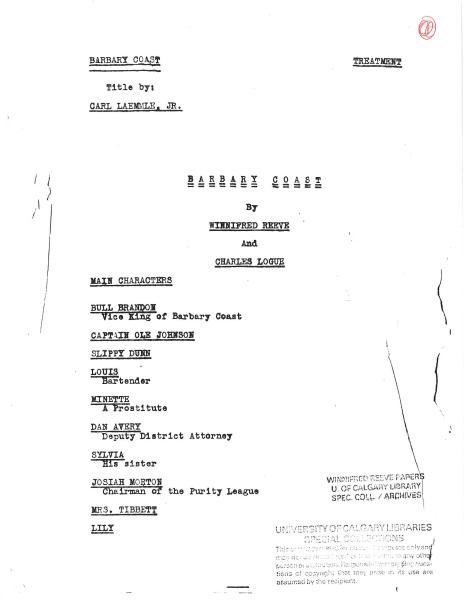 Barbary Coast TreatmentWritten by Winnifred Eaton and Charles Logue, the treatment for Barbary Coast follows Roger Storm’s attempt to sanitize the red light district in San Francisco and the conflict that arises through his infatuation for Lily, a proud resident of the district. Building on Eaton’s earlier outline, the Barbary Coast treatment makes changes to character names and various elements of the plot while giving a clearer voice to her characters through extended sections of dialogue, developing themes of race, class, and female companionship. Many of these revisions reflect the heavy film censorship of the Hays Code era, and despite the treatment being over sixty pages long, little of it, if any, survived the script’s editing and eventual production at MGM studios in 1935.
Read More
Written by Delaney Anderson, Amanda Law, Meghna Chatterjee, and Camille Lopez
Barbary Coast TreatmentWritten by Winnifred Eaton and Charles Logue, the treatment for Barbary Coast follows Roger Storm’s attempt to sanitize the red light district in San Francisco and the conflict that arises through his infatuation for Lily, a proud resident of the district. Building on Eaton’s earlier outline, the Barbary Coast treatment makes changes to character names and various elements of the plot while giving a clearer voice to her characters through extended sections of dialogue, developing themes of race, class, and female companionship. Many of these revisions reflect the heavy film censorship of the Hays Code era, and despite the treatment being over sixty pages long, little of it, if any, survived the script’s editing and eventual production at MGM studios in 1935.
Read More
Written by Delaney Anderson, Amanda Law, Meghna Chatterjee, and Camille Lopez
Technical Feedback
If you have noticed a bug, typo, or errors on the site or if you have any other feedback, please contact us.
People Mentioned
Joey Takeda
Joey Takeda is the Technical Director of The Winnifred Eaton
Archive and a Developer at Simon Fraser University’s Digital Humanities Innovation Lab
(DHIL). He is a graduate of the M.A. program in English at the University of
British Columbia where he specialized in Indigenous and diasporic literature,
science and technology studies, and the digital humanities.
Encoder
Author
Copy Editor
Editor
Sydney Lines
Sydney Lines is a Ph.D. candidate in English at the University of British
Columbia and Project Manager of The Winnifred
Eaton Archive. She is writing a dissertation on Winnifred Eaton
and Laura Goodman Salverson.
Encoder
Proofreader
Transcriber
Copy Editor
Mary Chapman
Mary Chapman is the Director of The Winnifred Eaton
Archive, a Professor of English, and Academic Director of the Public
Humanities Hub at University of British Columbia. She is the author of the
award-winning monograph Making Noise, Making News: Suffrage Print Culture and US
Modernism (Oxford UP) and of numerous articles about American
literature and women writers. She has also edited Becoming Sui Sin Far: Early Fiction, Journalism and
Travel Writing by Edith Maude Eaton (McGill-Queen’s UP) and
published essays on the Eaton sisters in American
Quarterly, MELUS, Legacy, Canadian Literature, and American Periodicals. Her current research project is a
microhistory of the Eaton family. For more information, see http://
Proofreader
Author
Transcriber
Author of Headnote
Copy Editor
Encoder
Compiler
Jean Lee Cole
Jean Lee Cole is Senior Consultant on The Winnifred Eaton
Archive, author of The Literary Voices of Winnifred
Eaton: Redefining Ethnicity and Authenticity (2002), co-editor of
A Japanese Nightingale and Madame Butterfly: Two
Orientalist Texts (2002, with Maureen Honey), and editor of the
original Winnifred Eaton Digital Archive (2004). She
is Professor of English at Loyola University Maryland.
Editor
Original Creator of Machine-Readable Version
Author of Headnote
Compiler
Spencer Tricker
Spencer Tricker is Assistant Professor of English at Clark University.
Author of Headnote
Transcriber
Ethan Eu
Ethan Xi Hao Eu is a PhD student in the Department of English Language and Literatures at the University of British Columbia.
Transcriber
Author of Headnote
Thomas Playfair
Thomas Playfair is a graduate of the Master’s Program in English at University of British Columbia.
Sijia Cheng
Sijia Cheng completed an MA student in English Language and Literatures at the University of British Columbia and was a research assistant for The Winnifred Eaton Archive. Her research focuses primarily on Asian Canadian literature and queer theory.
Sijia Cheng is an MA student in English Language and Literatures at the
University of British Columbia and a research assistant for The Winnifred Eaton Archive. Her research focuses primarily on
Asian Canadian literature and queer theory.
Encoder
Transcriber
Author of Headnote
Delaney Anderson
Delaney Anderson is a current Masters student studying English Literature at the University of British Columbia.
Transcriber
Encoder
Author of Headnote
Amanda Law
Amanda Law is a Master’s student in the department of English Language and Literatures at the University of British Columbia.
Transcriber
Encoder
Author of Headnote
Meghna Chatterjee
Meghna is an MA English student at the University of British Columbia. Her research interests lie in graphic literatures, queer studies and diaspora studies.
Transcriber
Encoder
Author of Headnote
Camille Lopez
Camille Lopez completed an M.A. in English Literature at University of British Columbia. Her research interests lie primarily in critical race studies and the early modern English theatre.
Transcriber
Encoder
Author of Headnote
- A document that has been proofed by the project director. Documents that are published may continue to be subsequently revised.
- A document that has been transcribed, encoded, validated, and edited, but is awaiting a final proof from the project director before publication.
- A document that is currently in progress and is not yet ready to be proofed. This may be because the transcription is in progress, a facsimile needs to be added, or for any other reason where the document has content but is not yet ready to be approved by the project director.
- A document that has not yet been transcribed or encoded. Do not use if we cannot find or otherwise we believe the text of this document is lost.
Full Revision History
| February 02, 2024 | SL | Published | Changed featured texts and updated blurb with current number of texts featured in archive. |
| August 14, 2020 | MC | Published | tweaked. |
| August 13, 2020 | MC | Published | Revised blurb more to acknowledge her problematic racism. |
| August 12, 2020 | MC | Published | Revised blurb to acknowledge her problematic racism. |
| January 20, 2020 | MC | Published | Revised blurb language. |
| August 07, 2019 | MC | Published | Changed featured texts. |
| February 19, 2019 | JT | Published | Created file. |